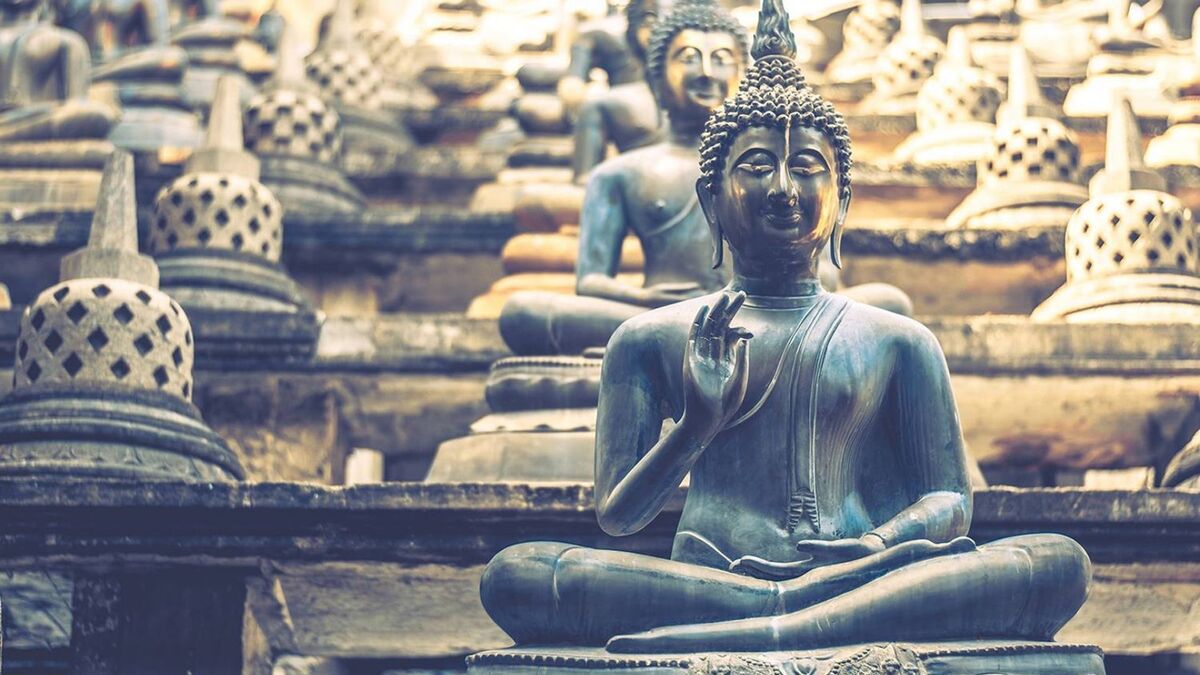Table of contents
General considerations on Buddhism

Buddhism is an oriental philosophy of life founded in India that seeks inner peace, decreasing the suffering of people through its teachings, questions about the universe, visions and practices. There is no worship of gods nor rigid religious hierarchies in comparison to Western beliefs, because it is an individual search.
Through meditation practices, mind control, self-analysis of daily actions and practices of good, lead the individual to full happiness. Buddhists believe that this physical and spiritual awareness leads them to enlightenment and elevation, this belief can also be found in other spiritualist paths.
This religion, or philosophy of life, is more commonly seen and practiced in eastern countries, more than in western countries. Read this article and learn all about Buddhism like the life of Buddha, History, Symbols, Strands, and more.
Buddhism, Buddha, origin, expansion and characteristics

Everything that involves Buddhism generates interest in people, causing some to adopt some practices in their lives and it is not necessary to be part of this religion for that. See in the next topics the history of Buddhism, Buddha, its origin, expansion and characteristics.
What is Buddhism
Buddhism is characterized by the use of teachings for the human being to let go of everything that harms himself and others, such as anger, envy, violence, exchanging it for love and good attitudes. One of the lessons learned in this philosophy is detachment, because everything in life is transitory, nothing remains forever.
In addition, Buddhism encompasses spiritual traditions, beliefs and practices based on the teachings of the Buddha and his interpretations, with Theravada and Mahayana as the major branches. In the year 2020 it was the fourth largest religion in the world with over 520 million followers.
The life of Buddha
The life story of the Buddha that the world knows was of Siddhartha Gautama, born in India in 563 B.C. and was a prince of the Sakia dynasty. Gautama spent his childhood protected from the outside world in his home until one day he decided to go out and for the first time saw a sick man, an old man and a dead man.
After seeing and discovering about human suffering, he met a traveler in search of spiritual enlightenment, thought that this individual would bring him answers to his questions and decided to join the practitioner to become enlightened. Then, he shaved his head as a sign of humility and exchanged his luxurious robes for a simple orange suit.
He also gave up all material pleasures, feeding only on fruit that fell into his lap. This idea was not very good, for he began to become malnourished. From this he constituted that no extreme is good, neither living on pleasures, nor living on the negation of those pleasures, but the best way to live is on the middle way.
At the age of 35, after meditating under a tree for 49 days, he reached Nirvana, creating the four noble truths. After his enlightenment, he went to the city of Benares, on the banks of the river Ganges, to transmit his discoveries and events.
The Beginning of Buddhism
After Buddha decided to share his path to achieving enlightenment and an end to suffering with others, his teachings became intermingled with the beliefs of Hinduism, an Indian religious tradition that is adapted to each region of the country. Each individual was free to practice and study it.
At the age of 45, his doctrine and teachings such as the "Four Truths" and "Eight Paths" were already known in all regions of India. However, only centuries after his death the Buddhist precepts were defined, prevailing two schools: Theravada and Mahayana.
The expansion of Buddhism
Buddhism was expanding throughout the various regions of Ancient India 3 centuries after Gautama's death. After spreading to Asian countries around the 7th century, it eventually became more forgotten in India, with Hinduism remaining the religion of the majority of the Indian people.
Only in 1819 it arrived in Europe and there were some new concepts made by a German named Arthur Schopenhauer. Then it finally expanded around the world, with several Buddhist temples in some countries in Europe, the Americas and Australia.
Buddhism in Brazil
In Brazil, Buddhism has similar characteristics to other countries. For example, the fact that this country was home to Japanese people and their descendants brought many Buddhist priests and instructors who spread throughout the Brazilian territory. As time went by, the Japanese descendants became Catholics and Buddhism was forgotten.
However, according to the IBGE (Brazilian Institute of Geography and Statistics) census, the number of followers and practitioners of Buddhism began to increase from 2010. Brazilians who are not of Japanese descent have begun to seek and study more about this religion and converting to it, although many convert to other religions or none.
The main characteristics of Buddhism
Buddhism has characteristics that make it unique and welcoming to anyone, using a series of teachings and meditation practices for detachment from matter and suffering, towards spiritual evolution. In this philosophy, there is no beginning or end, with Nirvana being the ideal stage, but it can only be perceived and not taught.
In addition, the subject of karma is also widely discussed in this religion, all intentions and attitudes, good or bad, generate consequences in this or the next life. Rebirth, or reincarnation, is a natural part of life until one leaves the cycle of suffering, reaching enlightenment. This cycle is called the "Wheel of Samsara", governed by the laws of karma.
Differences between Buddhism and Hinduism
The main difference is that in Hinduism there is the belief and worship of the gods. In addition, it is a philosophy of religious order that encompasses cultural traditions, values and beliefs through the medium of other peoples, wishing to achieve knowledge through the gods.
Buddhists, on the other hand, have no belief in gods and seek Nirvana, which is the full state of peace and happiness, through the teachings of Buddha. As it spread throughout Asian countries, it had more followers in China, becoming the official religion of that country.
The meaning of the symbols of Buddhism

Like many other religions and philosophies, Buddhism also has symbols that it uses in its teachings. To discover the meaning of the symbols of Buddhism, read the following texts.
The Wheel of Dharma
The image is a golden chariot wheel with eight spokes, representing the teachings of Buddha and being the oldest Buddhist symbol found in Indian arts. Besides Wheel of Dharma, it can also be translated as Wheel of Doctrine, Wheel of Life, Wheel of Law or simply called Dharmachakra.
The Wheel of Dharma corresponds to the main law of the universe and represents the summary of all the Buddha's teachings, while the spokes represent the Noble Eightfold Path, which are the main foundations of Buddhism. In other words, it describes the cycle of death and rebirth that is natural to all beings until they reach enlightenment, ending this cycle.
The Lotus Flower
The Lotus (padma) is an aquatic plant that thrives from water, its roots growing through the muddy slime of lakes and ponds and then rising to the surface to bloom. The Lotus is similar to the Victoria Regia, which is also an aquatic plant and is native to the Amazon region, with a few minor differences.
As a Buddhist symbol, it depicts purity of body, mind and spiritual elevation. Muddy water is associated with attachment and ego, while the plant that grows amidst this water reaches the surface and its flower blooms, associating it with the search for light and enlightenment. In addition, in some Asian religions such as Hinduism, deities appear seated on a lotus flower in meditation.
Goldfish and Shells
In Buddhism, goldfish represent beings that practice the Dharma, have no fear of falling into suffering, can choose their rebirth and are free to go wherever they want. Besides symbolizing good luck, these animals are sacred in India and have other representations such as freedom and the rivers Ganges and Yamuna.
Shells are shells that protect mollusks and other small soft-bodied sea animals. They symbolize power and protection, especially of authorities such as parents and teachers who educate and teach about life. Furthermore, it represents direct speech and the awakening of beings from ignorance.
Infinite knot
The Infinity Knot has the iconography of flowing and intertwined lines creating a closed pattern, it can be described as four interconnected rectangles, two on the left diagonal and two on the right diagonal, or, some interconnected squares seeming to form a hexagonal.
In Buddhism, this symbol represents the dependent origin and interrelationship of all manifestations. It also symbolizes the cause and effect of the union of compassion and wisdom, two characteristics that are important for living with more wholeness and less suffering.
Theravada, Mahayana and the different strands of Buddhism

Buddhism has several schools, each one being part of a different branch. Some are more traditional and ancient, others use more practice to reach the same path as the others, enlightenment. Continue reading and learn more about Theravada, Mahayana and the different branches of Buddhism.
Theravada
In a literal translation, Theravada means Teachings of the Elders and is one of the main strands of Buddhism based on the oldest and most complete record of the Buddha's teachings, the Pali Tipitaka. This strand is more conservative and focused on the monastic life of the forms of this religion.
Theravada is focused on the principles of Dhamma and approaches all with simplicity such as discipline, ethical conduct of monks, meditation and internal wisdom. Currently this strand is most practiced in Thailand, Sri Lanka, Burma, Laos and some South and Southeast Asian regions.
Mahayana
Mahayana means The Great Way and is the most numerous of the traditions with its origins since the passage of Siddhartha Gautama on the planet, having the writings preserved in Chinese as his teachings spread throughout Asia.
This school holds that anyone can follow the path to enlightenment and attain it, also claiming that its teachings are relevant to all people. Mahayana is the dominant branch of Buddhism that is present in India and is currently practiced in China, Korea, Taiwan, Japan and also Vietnam.
The other strands
Besides Mahayana and Theravada, there are other branches of Buddhism such as Vajrayana, or Lamaism, which arose in India in the sixth and seventh centuries, where Hinduism was being reborn in the country. With this, some followers were influenced by some characteristics of this religion, such as the worship of gods and rituals.
Vajrayana means The Diamond Path, used to defend its ideas and there is a hierarchical structure where there is a master responsible for teaching the knowledge and practices called Lama. For example, Dalai Lama was a spiritual leader of this branch and political leader of Tibet.
Buddha, Dharma and Sangha for Buddhism

In this religion, every detail, every symbol, every teaching has its meaning just like any other religion or philosophy. Read and discover below the concepts of Buddha, Dharma and Sangha for Buddhism.
The Buddha concept
The name Buddha means "one who has awakened" or "enlightened". He was the man who managed to become enlightened and rise spiritually, reaching Nirvana and a high stage of wisdom. It also represents the image of Siddhartha Gautama, the Buddha, who founded Buddhism.
This title is given to people who fully attain the highest level of spiritual awakening by disseminating their discovery and knowledge with others. For example, in traditional scriptures, Buddhism mentions 24 Buddhas who appeared in different past eras.
The concept of Dharma
The word Dharma, or dharma, comes from Sanskrit meaning that which keeps high and there is no exact translation in Western languages. In addition, it is often used in Indian religions or philosophies such as Hinduism, being a universal law and the performance of duties.
Responsibility and the fulfillment of duties establishes the basis of social and spiritual life, indicating the legal rules and duties of each person. The Buddhist Dharma is used as a guide for each individual to reach the truth and understanding of life. It can also be called natural law or cosmic law.
The concept of Sangha
Sangha is a Pali or Sanskrit word that has a translation that can be association, assembly or community and usually refers to Buddhism, specifically the monastic communities of Buddhist monks or the followers of Buddha.
Therefore, Sangha will be all communities and groups of people who have the same goal, life vision or purposes. Furthermore, it was established by Gautama in the 5th century B.C. so that people can practice Dharma full time, following rules, teachings, discipline and away from the materialistic life of society.
The Four Noble Truths of Buddhism

One of the most important teachings and pillars of Buddhism are the Four noble truths, in which no being is free from. To know more about these Four noble truths, continue your reading.
The first noble truth
According to Buddhist teachings, the first noble truth is that life is suffering. However, this phrase has no exact meaning, and can represent anything from dissatisfaction to the most intense suffering. Nothing in this world is permanent, so suffering comes from the fear of losing physical things, even relationships and people to which one is attached.
Therefore, it is necessary to practice detachment in order to have a lighter life with less affliction. For example, Buddha was only able to finally become enlightened when he gave up meditating until he died under a tree trying to find the answers he was seeking. Once he gave up, he found the answer and became enlightened, so renouncing desire is the fastest way to end suffering.
Two sufferings
The Two Sufferings are the inner and the outer, elementary classifications found in Buddhist sutras. The term sutra in Buddhism refers to the canonical scriptures that have been recorded as oral teachings of Gautama Buddha that may be in prose form or put together as a manual.
In this way, people can understand the origin of suffering more easily. Internal suffering is the pain that each individual feels, starting from each one, and it can be a physical pain or a psychological problem. On the other hand, external suffering is that which comes from what is around each living being and it is not possible to avoid it, and it can be a storm, cold, heat, wars, crimes, among others.
Three sufferings
This classification talks about illusion, since the human being lives in a third dimension plane, where everything is changeable and everyone is subject to this by the fact of being alive in this plane to evolve. It is common and normal that people feel fear and impotence when seeing everything changing suddenly, realizing that they have little control over their own lives.
Suffering arises from denying this reality and wanting to control everything that is external and what happens to oneself. Each person can control only the way they will act, think and choose, according to what happens in life. One must be prepared to face the truth, at some point everything comes to an end.
Eight sufferings
Finally, the Eight Sufferings describe in detail every suffering that sentient beings will face, nothing is inevitable. They are birth, aging, illness, death, loss of a love, being hated, having your wishes unfulfilled, and finally the five Skandhas.
The five Slandhas are all forms, sensations, perceptions, activities and consciousness. Together they form conscious existence and the means for experiencing life in matter and manifesting suffering, incarnation after incarnation.
The second noble truth
The Second Noble Truth shows that suffering is caused by desire, mainly for material things and vices, since nothing on this planet is permanent. This happens because desires change when one is fulfilled, the human being is unsatisfied and is always looking for new things and stimuli.
That doesn't mean that people can't want an object, a food, a large property or jewels. The best path will always be the middle one, without attachment and without sloppiness, enjoying life in the best way possible, but with the awareness that all cycles come to an end some day.
The third noble truth
Attachment to the outcome and to all that is external causes suffering. This ends when the individual becomes free of the desires, not when he conquers them. However, there is a phrase by Aliib Abi Talib that further explains the Third Noble Truth: "detachment does not mean that you should have nothing, but that nothing should have you.
Therefore, suffering only ends when the human being frees himself from the desire, to possess material things and people, to want to control everything around him. This attachment is nothing more than the fear of losing control over his life, over others and over situations.
The fourth noble truth
Finally, the Fourth Noble Truth speaks about the truth of the way to end suffering, showing what a person must do to overcome all the causes of that pain toward Nirvana. A simple and quick way to end the cycle of suffering is to follow the Noble Eightfold Path.
To follow the Noble Eightfold Path one must learn to have right understanding, right thought, right language, right action, right way of life, right effort, right full attention, and right concentration.
The importance of the four noble truths
The Four Noble Truths were the Buddha's first and last teachings. As he neared his death, he decided to answer all his disciples' questions about these truths before the time came for him to leave, so, at the age of 45, he explained all the importance attached to these teachings.
In Buddhist schools, the early years are devoted to the study of the Four Noble Truths, divided into three periods called the Three Spins of the Wheel. This division makes it easier to understand these teachings of the Buddha from three different perspectives, each seeing the same truths.
The root causes of suffering

Suffering also arises from the lack of harmony in various areas of life. Everything that is out of balance brings discomfort and unpleasant consequences until that situation is rebalanced. Continue reading and discover what the fundamental causes of suffering are.
Lack of harmony with the material world
Harmony means the absence of conflict, a light and pleasant feeling, being in connection with everything, everyone and oneself. Religions and life philosophies around the world talk about having harmony in life, the importance of it and that it covers for various situations.
The lack of harmony with the material world causes serious problems in the life of the individual, and can range from blocking paths to fall into addictions, whether of drugs, food, drinks, games or sex. The practice of detachment is essential to lead a lighter life and without obsessions or addictions.
Lack of harmony with other people
From relationships with family to a husband or wife, a lack of harmony with other people brings problems in communication and relationships throughout life. This imbalance brings conflict, feelings of loneliness and broken connections and alliances.
There are several causes of disharmony in any relationship such as selfishness, individualism, lack of empathy and emotional imbalance. To have harmony with people, one must learn to share, listen, understand, help and one must not overstep the boundaries of the other.
Lack of harmony with the body
The lack of harmony with one's own body is more common than one might think, because society imposes standards and those who do not follow the standard end up being ridiculed, diminished, excluded from social groups. It is not necessary to be ridiculed to be in disharmony with the body, the individual himself does not like the way he looks.
The thought of rejecting the appearance of the body can come from a distorted view of oneself, obsession, low self-esteem, lack of self-love or trauma. The person seeks to have surgeries, diets, spending a lot of money in these processes because they do not accept themselves the way they are. As a consequence, it can bring problems in physical health and financial life.
Lack of harmony with the mind
The disharmony with the mind is very common, most people in the world are misaligned with their own mind, for example, have anxiety, childhood traumas, many negative or obsessive thoughts, lack of focus, among others. Besides shaking the mental and emotional health, this reverberates in the physical health.
To rebalance and have harmony with the mind, it is necessary to be accompanied by a professional, either a psychologist, therapist or psychiatrist. One of the first steps to have a good mental health is to seek emotional balance and reduce the excesses in life.
Lack of harmony with desires
It seems contradictory to show the consequences of the lack of harmony with desires when Buddhism teaches that the end of suffering comes from detachment from them. However, the human being is driven by desires and curiosity, craves for novelty and this is natural, this makes society as a whole evolve.
The material things can be used in the best possible way and the most sustainable. What can not happen is to let yourself be carried away in vices, selfishness and materialism, living only to accumulate and have the best material things. The accumulation of material objects that have no use in life brings the blockage of path and stagnation of energies.
Lack of harmony with opinions
Human beings worry too much about what others will think and this becomes a disturbance that negatively affects one's life. A person does not manifest the way he or she is, acting differently from what is natural just to be accepted or to please someone in society.
It is not healthy to take attitudes that others expect you to have, this will erase the essence of each individual, you lose autonomy and can not position yourself in the face of some discussion. Moreover, while one is concerned about the judgment of others, the other may not be judging.
Lack of harmony with nature
The disconnection and detachment of humanity with nature bring great catastrophes for people, animals and the planet itself. This lack of harmony with nature makes man think that everything is available for him to enjoy and that resources are infinite.
The consequences of this disharmony is the destruction of forests, seas, rivers, exploitation and extinction of animals, accumulation of non-recyclable waste, food with toxic products, making the earth infertile over time and climate change. However, all these actions one day return to the human being in the form of disasters, shortage of resources and even death.
What is the meaning of Nirvana for Buddhism?

Nirvana is described by Gautama Buddha as a state of peace, calmness, purity of thought, tranquility, liberation, spiritual elevation and awakening. By reaching this state, the individual breaks the process of the wheel of Samsara, meaning that reincarnations are no longer necessary.
This term comes from Sanskrit, translated as cessation of suffering. In Buddhism, the concept of Nirvana can be used for other situations, for example, representing or indicating death. Also, many people see the attainment of this state of peace as a closure of karmas.
Therefore, to attain Nirvana one must renounce material attachment, as it does not bring spiritual elevation but rather suffering. With time and practice, the negative characteristics of one's personality diminish until they no longer manifest, such as hatred, anger, envy and selfishness.

